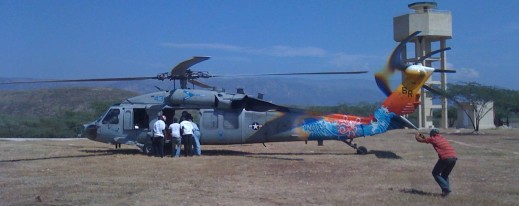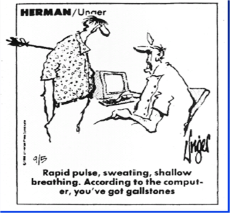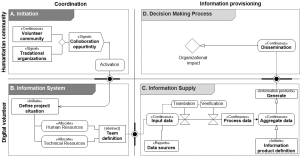A colleague in information management from the United Nations Office of Coordinating Humanitarian Affairs wrote a great blogpost a few weeks ago and I was inspired to reflect more about the cues that influence decision-making.
As an emergency medicine clinician of almost 12 years, I began my specialty career, head down – learning a trade and practice – only to look up sometimes just to eat and go to the bathroom. Over the years, I have been working and interacting with people in humanitarian assistance, information management, and technology. This has been an enlightening experience. And the trans-disciplinary environment has helped me also reflect on my career as an EM physician.

I came to realize sitting in conferences, chatting with traditional and digital humanitarians colleagues, and lecturing across the country that my career as an emergency medicine physician (aka ER doc) was just as much about real time situational awareness, fast-cycle decision-making, and risk taking with innovation than I had ever realized. I learn so much talking and thinking about these ideas with my humanitarian IM and crisis mapping colleagues. And when I walk into the Department (the ER as many say) I enact much of what we talk about. Traversing these two worlds has helped me work to bridge the struggles and successes we face in humanitarian technology and information management. It also helps me see my work as a doctor in a busy urban ER in new ways.

There are clear and stark differences between the dynamic and sometimes chaotic ER and humanitarian crisis that should not be overlooked. IMHO A bad night in the ER is by no means a controlled disaster, or a humanitarian crisis, and should rarely be equated to these settings. But the often frequent information explosion, fragmentation of information streams (radio, the physical exam, electronic medical records, x-rays, rounds) , multiple stakeholders with varying agendas, politics (and more politics) are somewhat similar. Both settings have varying degrees of uncertainly, high risk and high acuity situations.
One of the first things we teach emerging physicians rotating in our Department is the “sick…not sick” skill set. There is no recipe or checklist for this; it’s a built and learned experience. It requires multiple senses, getting up, walking to the patient room, talking with paramedics and interacting with the patient. There is no “code card” for determining if someone looks sick, they just do. And right before they “code” ER docs will frequently remember that moment, and collectively over the years, they build a body of experience of what that is and that collective experience of “sick”. ER physicians not only think about what decision to make from recognizing patterns in complex clinical environments but they also react and respond.

I recall one of my cues in 2010— the sound of helicopters. And the heli sounds make me think of patient transfers at our field hospital in Haiti. And it sets off a chain of learned activities, find the patient, let the medical team know, confirm that we have the patient record… oh well… chase down those patient records… find family, inform family, translate, ensure the landing areas is safely clear.

I was also an information user, collector, and provider. Some people may have though that as a field practitioner in health one of my primary cues would be a map, or a sitrep. For much of the day it was not. It was primarily SMS, my two radios and the heli sounds. Online and advanced digital products much much less so… except for excel and email which we used to created census lists and crunch numbers for the Flash Appeal. One exception during my second deployment was Humanitarian OpenStreetMap‘s online maps, that I printed for patient ground transport.
As a researcher and consultant for NGOs helping with rapid assessments, post emergency assessments and program evaluations, I’ve used a lot of sitreps, maps, and traditional information products. That was my primary cue at times. But for example in 2007 as I headed deeper into Sofala Province in Mozambique toward Chupanga my connectivity tailed off to only a BGAN… and not such a good one honestly. Just one email/day. And the challenges with limited connectivity were in similar in some ways for my Disaster Resilience Lab colleagues whom I supported remotely in the aftermath of the 2013 Typhoon Haiyan. I lost SMS connectivity with them as they reached Tacloban and much of their time in Guiuan.
The route of information products to users becomes paramount when we think about “timely” information products that are being produced 50-100+/day or more in this age of disasters.
The conversation continues about how humanitarian field staff make “decisions” often from those who may infrequently make them in similar contexts. This certainly adds to the conversation, but has always left a bit of tension within me. Some have stated that field humanitarians are not logical in their decisions and are just reactionary. While some of this may be true, it leaves me uncomfortable with discussions that imply that one can’t have that “gut feeling” along with thoughtful evidenced-based decision making. In emergency medicine both the gut feeling and the evidence are powerful aspects of our work. We recognize and respect both.
In the ongoing exploration and understanding of how multiple stakeholders make decisions during humanitarian crisis, I agree we may not yet know enough yet to make such stark statements one way or another.
Medicine has been remarkably forward recently with reflecting upon errors. Because we as an institution have made some grave and horrible mistakes, and have learned the hard way – much like humanitarians. And a recent article in the British Medical Journal (BMJ) of Quality and Safety by two authors discusses a similar dichotomy that I think we are discussing in humanitarian IM. Both relate to improving the way we use information for decision-making. One end of the spectrum is behaviors and senses (cognition), the other is systems related.
“The putative distinction between ‘cognitive’ and ‘system’ becomes somewhat spurious when one considers the diagnostic work of a busy emergency department with its chaotic mix of system-based, cognitive, affective, perceptual, temporal and variable patient factors. Of course, both cognitive and system variables can be manipulated and tested separately, but with both types of variables interacting in the clinical setting, the interaction term in our analyses should be of just as much interest as the main effects.”
Henriksen, K., & Brady, J. (2013). The pursuit of better diagnostic performance: a human factors perspective. BMJ quality & safety, 22(Suppl 2), ii1-ii5. (open access)
I’d like to think that this may be true of humanitarian practitioners in the field, including those directly involved in last mile humanitarian operations. This is no easy task, actually it’s a really really hard task. And I hope that these perspectives in the field of medicine will be shared and recognized across disciplines and communities of practice.
“The perils of embracing dichotomies too eagerly are ever present—no less for the learned than the uninitiated. Of course, they may serve as useful fictions or labels initially in helping to simplify complex phenomena. But dichotomies tend to assert too much, feeding delusions of understanding when their overuse impedes it. Instead of serving as convenient short-hand labels, they uncritically take on explanatory power, serving as causes rather than consequences. Parsing the world into imperfect humans and imperfect systems, into cognitive versus system-based research approaches, and into system 1 (intuitive) versus system 2 (analytical) modes of thinking,23,24 misses much of the human factors work on shared mental models and distributed cognition cited earlier.”
How the above reads to me is that we should pause to further consider this debate of “how field staff make no informed decisions” to “we just need a tech influenced decision support system on an iphone app”. There is no correct camp that will solve this challenge in Emergency Medicine; nor in humanitarian crisis which is an exponential increase in acuity, uncertainty and chaos. The answer lies in a nuanced mix of the two, with a respect for each.
 Much in a similar way the the current generation of EM clinicians use their senses and learned experiences to care for patients but trust and abide by studied protocols, diagnostics and tested interventions. Cardiac arrest, acute stroke and sepsis are a few examples. But among all of the patients who are affected by these grave clinical conditions, we still strongly respect the “sick… not sick” sense that we have in this specialty.
Much in a similar way the the current generation of EM clinicians use their senses and learned experiences to care for patients but trust and abide by studied protocols, diagnostics and tested interventions. Cardiac arrest, acute stroke and sepsis are a few examples. But among all of the patients who are affected by these grave clinical conditions, we still strongly respect the “sick… not sick” sense that we have in this specialty.






 Much in a similar way the the current generation of EM clinicians use their senses and learned experiences to care for patients but trust and abide by studied protocols, diagnostics and tested interventions. Cardiac arrest, acute stroke and sepsis are a few examples. But among all of the patients who are affected by these grave clinical conditions, we still strongly respect the “sick… not sick” sense that we have in this specialty.
Much in a similar way the the current generation of EM clinicians use their senses and learned experiences to care for patients but trust and abide by studied protocols, diagnostics and tested interventions. Cardiac arrest, acute stroke and sepsis are a few examples. But among all of the patients who are affected by these grave clinical conditions, we still strongly respect the “sick… not sick” sense that we have in this specialty.
